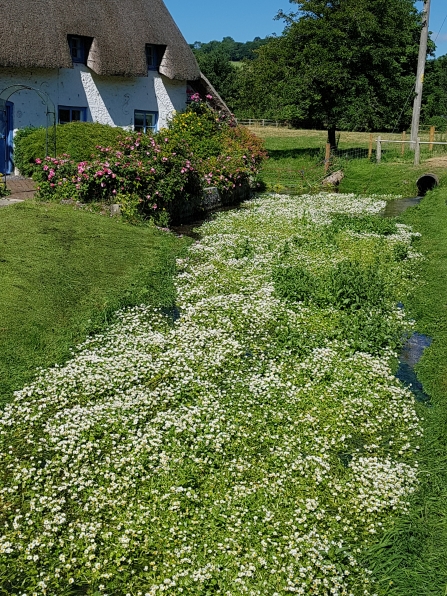
A winterbourne full of flowering Water Crowfoot (Ranunculus aquatilis) in front of a whitewashed thatched cottage.

A winterbourne full of flowering Water Crowfoot (Ranunculus aquatilis) in front of a whitewashed thatched cottage.
My personal mantra has always been “I want to make a difference”, so getting a job on HLF landscape-scale conservation project Watercress & Winterbournes meant a lot to me.
Watercress & Winterbournes empowers local people to make a difference. We believe that community-led local projects will result in sustainable improvements to our precious chalk streams. When I say “we”, I mean the 16 partner organisations, the Heritage Lottery Fund and all the local people who have been involved in the research phase – we all feel this project is vital to the health of our streams.

The crystal-clear, mirror-still chalkstream tumbles over some carefully positioned rocks.
We can see some drifts of submerged water crowfoot in the gravel bed.
Being my first blog (cue much eye-rolling from my children), I thought I’d tell you what I’ve been up to since I joined the project in March, whilst sharing some pictures I’ve taken in the headwaters.
As Community Catchments Officer, I’ve met many people on the Test and Itchen with different interests, motivations, wishes and experiences. What brings us together is our love and concern about our chalkstreams. It's exciting to see that everyone I’ve met is interested in the project and passionate about their stream.

A sunny side view, from under a tree, of a peacefully meandering chalkstream.
There are tufts of in-channel vegetation rising from the surface.
We can just spy Water Mint (Mentha Aquatica) and Water Forget-me-not (Myosotis scorpioides).
I owe thanks to the many kind locals who have taken me to little-known paths, taught me local place names, shared their stories and showed me potential projects. This development phase of Watercress & Winterbournes relies on such enthusiasm. It takes a community-led, bottom-up approach to identify local projects and initiatives. These will be written into a bid for submission to the Heritage Lottery Fund in October 2019.
I am running nature walks and talks giving local people the chance to try out kick-sampling (a bit like pond dipping in a stream). We do this to see what river invertebrates are present as they can tell us a lot about the health of a stream. We will also monitor the phosphate levels in the streams with simple testing kits. High phosphate levels encourage algal growth and adversely affect the in-stream habitat.

Two table top observation trays full of water and chalkstream invertebrates.
In the background are identification charts and magnifying glasses used to spot the animals.
We will soon have a range of volunteers’ workshops and seminars available. As an example, we will learn how to monitor where silt is entering a stream. Too much silt smothers invertebrate and fish eggs and stops oxygenated water reaching them. They need this oxygenated water for healthy development.
We will map built heritage, for example hidden water meadow structures, to celebrate our heritage. If you have stories to tell about your time on or around the chalkstreams, or you know where hidden heritage lies, I’d love to hear from you.
Community catchment groups are forming now along Pillhill Brook, Upper Anton, Bourne Rivulet, Upper Test, Candover Brook, River Arle and Cheriton Stream.

A cartoon story in which two characters are discussing Watercress & Winterbournes.
If this development phase is making you feel impatient and you want to do something right now, two things spring to mind. You could find out about the impact your dishwashing tablets or washing powder is having on your stream. Or, if you are lucky enough to garden next to a stream, do as the late Oliver Rackham suggests in his book The Illustrated History of the Countryside, “resist the impulse to tidy up”. Obviously, I don’t mean leave crisp packets lying around! ... more leave a natural or unkempt patch for wildlife.
Or, you could contact me today to say you’d like to be involved :)

We can see a school playground full of shaded stalls, in preparation for the start of the Summer Fair.
In the foreground is a table with trays of water invertebrates.
To register your interest in the project, or to find out about volunteering opportunities, please do get in touch.
My email address is maggie.shelton@hiwwt.org.uk and direct landline is 01489 77 44 28.

A Bullhead (Cottus gobio) caught during some kick sampling being studied in an inspection pot.
In the background are locals surveying the stream.